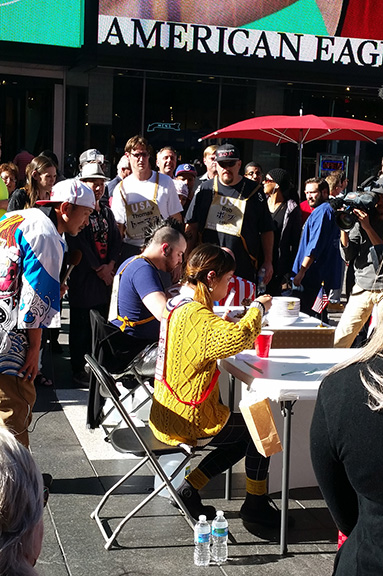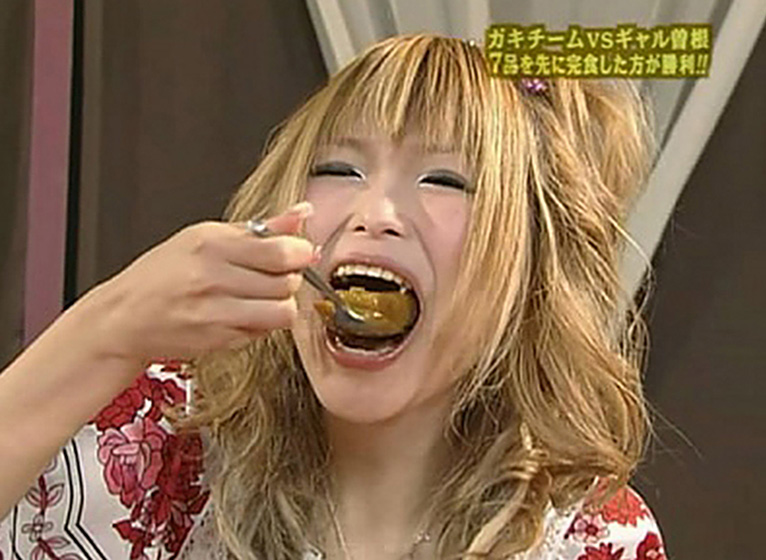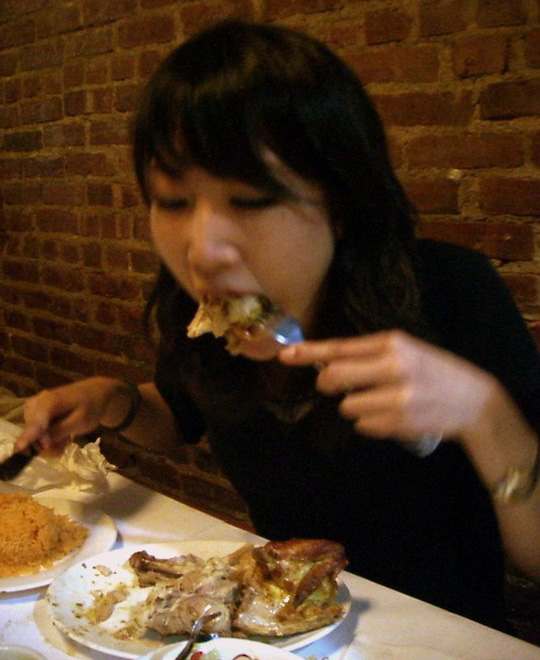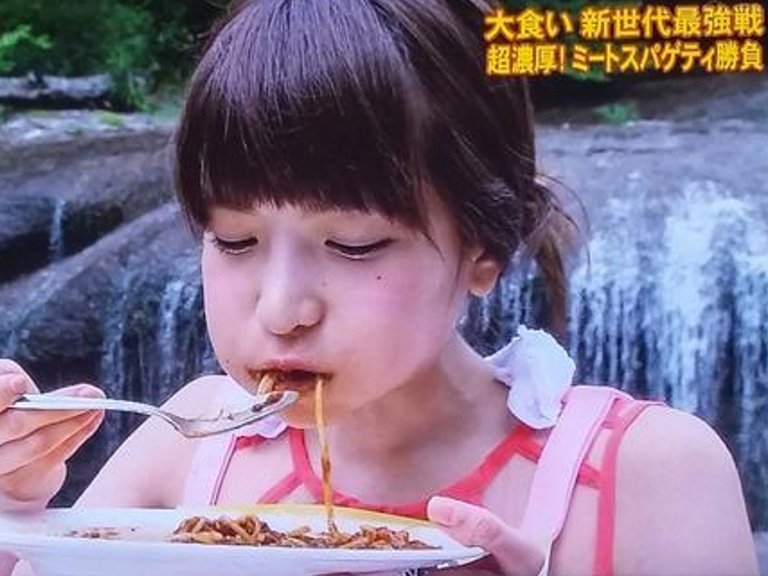Female stars embody the addictive contradictions of competitive eating
IT'S just past noon at Times Square on a Wednesday, and people have gathered around two people sitting at tables, eating bowls of rice with beef. One is a white American man with a mohawk and a beard, with the build of a bulky football player. The other is a small. skinny Japanese woman, a little over five feet and probably 100 pounds, with a side ponytail and a baggy yellow sweater that makes her look like a schoolgirl. They’re barely chewing the food in front of them; they’re swallowing by the spoonful, gulping it down at a steady pace. The spectators are a mix of Midtown office workers out on their lunch break and random tourists who look like they’ve just stepped out of a Big Bus tour. It’s November 4, and everyone is shocked by how warm the day is. But the people standing around me are more shocked by this absurd display occurring in front of us. The American eater is almost done with his 10th bowl. The Japanese woman stacks her 11th bowl in front of her and raises her hand, as someone rushes to her table with her 12th.

“She’s so tiny.”
“Look at how skinny she is.”
“She can’t possibly have eaten that much.”
An old European lady asks me what’s going on. “They’re taping an eating contest,” I say. “It’s for a Japanese TV show called the Big Eaters World Championships, and it’s the final round between Team America and Team Japan.” I know this because my husband helped coordinate this show. He’s a few feet from me, urging spectators to take a few steps backward because they’re blocking the cameras.
“Ten minutes left!” the Japanese host says, pointing to a large digital timer and ceremoniously beating a taiko drum in his hand. Everyone claps. The contest is based on how many bowls of rice with beef they can consume in 30 minutes—the amount of time it takes an average person to finish just one bowl, maybe two, before they feel completely stuffed.
“USA! USA!” people start chanting. Even people who aren’t part of this crowd, who hear this chant, start chanting along in other parts of Times Square. Such is the nature of the chant; it doesn’t have to have context to be contagious.
On Japan’s side, the three other Japanese contestants are trying to work up their own chant: “Nippon!” (clap clap clap) “Nippon!” (clap clap clap)—the usual cheer the Japanese give in the Olympics and other international games. They’re completely drowned out by the “USA”s.
In the end, the Japanese eater loses by one bowl. The American wins, and Team America wins this year’s Big Eaters World Championship. There’s more clapping and cheering. But while everyone is happy for the American and the surreal thing they just witnessed on their lunch break, they’re still mesmerized the Japanese woman, who everyone keeps calling “girl.”
“But the girl. She can eat.”
“I wonder what her stomach looks like.”
I know how that feels, to be the small girl who can eat a lot. The glamour and warm feeling that comes with it, and the ability to mask what must be done to maintain it.
WHEN I lived in Tokyo, my parents and I would glue ourselves to the television to watch TV Tokyo’s Big Eater Championship every time it came on. There was something about this series that intrigued all of us in different ways. My mother would take note of the food they ate, which was often chosen to promote a trendy new restaurant, while my father, the doctor, would try to diagnose what was happening in the contestants’ organs as they shoved impossible amounts of food down their throats. We all found it simple, addictive entertainment. The format was the same every time, the shock and awe the same, and we would either come out of the viewing experience hungry for exactly the foods they were eating or too disgusted to touch our meals. It was usually the former.

From 2005 to 2008, the reigning Japanese eating champion was a woman named Natsuko Sone, who every Japanese person knows as Gal Sone (pronounced Gyaru Soh-Neh). With her dyed blonde hair, thick makeup, and clothes inspired by the “Gal” fashion trend of short skirts, loose leg warmers, doll-like eye makeup, Gal Sone was the first iconic embodiment of “the girl who could eat.”
After winning each round, she would smile at the camera and say things like, “Mmm! That was so tasty! I could eat more! Now I want ice cream!” More awe and laughter would follow.
From 2012 to the present, Gal Sone was surpassed by another big eating champion: Azuki Moeno, nicknamed Moe Azu. Moe Azu is extremely feminine and adorable in her own way: She’s a minor pop idol in Akihabara, where AKB48, the most famous Japanese pop idol group to date, is also based. It’s just as incredible to see her channeling the shy, naive schoolgirl voice and mannerisms while gorging on plate after plate of food.
There’s an appealing contradiction in watching these women at work. Look how much she can eat despite the way she looks. Look how she looks despite how much she’s eating. There’s a word in Japanese that describes these women perfectly: kuishimbo. It means someone who likes to eat, someone who’s always hungry, and it’s a word usually used to describe children.
It’s the magic of the Little Big Eater Girl. She’s skinny, prepubescent, and childlike in her seeming ignorance about what constitutes an appropriate portion of food. And yet she’s an adult. If you take her on a date, she won’t order just a salad but every item on the menu and beg for dessert after. After enjoying every spoonful of this giant meal, she still looks healthy, small, and fuckable.
The magic, though, only exists on TV, where all ugliness can be edited out and audiences need never suspect it had ever been there in the first place.
PEOPLE are surprised when I tell them I used to be fat. But as a child I had three rolls on my stomach that left stretch marks that are still visible. Growing up in Tokyo, this was particularly embarrassing, given how small and skinny everyone else is, including the adults. In my ballet class, the teacher constantly criticized my protruding belly, patting it in front of all the other skinny girls. Such is the nature of classical ballet. It’s not abuse if it’s for the sake of discipline and art. When we put on Alice in Wonderland as a summer performance, I was given a playing-card costume to help conceal the fat.
I was eight when we moved to California, where my chubbiness garnered me the nickname Yuri McFlurry. I don’t remember who invented it. It may have even been me. By then I’d learned to embrace being fat and no longer took offense. I even made Yuri McFlurry my first AIM handle.

When we moved back to Tokyo three years later, I was in my early teens, and being fat was a nuisance. It was then I noticed how skinny girls could eat and eat while remaining skeletal. If I wanted to be like them, I was going to have to manufacture it myself. So I chose bulimia.
Of course it was disgusting, and of course it was painful. But for many years it was worth it, an easy sacrifice for what I’d gained. I looked like a woman but ate with a childlike ignorance of nutrition and logic. I was the girl who loved food, who always ordered the meatiest, fattiest thing on the menu and later had room for dessert. I was the girl who ate candy bars followed by milkshakes followed by another midnight snack while appearing as though I’d eaten nothing. I was a contradiction, and I liked what it said about my personality.
I started staging eating contests in front of my then boyfriend and close friends. Around the middle of the meal, I would declare, “I bet I can eat the rest of this plate in three minutes. Time me!” I never bet money or anything. I wasn’t competing against anyone but myself, and if I lost my own bet, it was only ever by a few bites. I did it for the attention and laughter; I did it to impress. Look how much I can eat, and look how thin I am. Right on cue, my audience would say, “But you’re so small, how can you eat so much?” And when no one was looking, I found ways to make sure my body never absorbed the food.
“Look how much I can eat.” “Look how much of this food I can shove into my mouth at once.” “Look how much I can eat in just one minute,” “I’ll finish the whole plate, I bet you your next beer.” “Look how much I can eat in 30 seconds.” “Ten.” By the end of college I had made myself into Gal Sone and Moe Azu: a little Japanese big eater girl. In the process I had won over the love of my life with this circus performance. Our first dates revolved around my eating contests, and I loved that he was awed by them. Five years later, he would start working with Japanese TV shows, among which were the Big Eater competitions. Two years after that, we got married, and it was around this time that I realized that I had a serious eating disorder.
It took several months to quit the habit. I had to relearn how to really consume the food I was putting in my mouth instead of treating it like a prop in a performance, adjusting the amount and pace at which I ate everything, having to say, “No, I’m full,” instead of “Of course I can eat that, I’m so hungry I could eat a whole cow.” I acknowledged that my body would accumulate the water and the fat and that I would no longer be the “small girl who could eat.”
I came out to my husband about the bulimia only after I fully recovered from it. His first response, after the shock, was worry that he had inadvertently encouraged my Little Big Eater Girl act for all those years. “No,” I said. I had been putting on eating contests long before we had met, and though I was glad he enjoyed the show, I wasn’t putting it on to keep him. I was more addicted to embodying a contradiction. I was entertained by my own show.
During those years, I believed that it would be perfectly fine to keep going, that no one ever needed to know. But it became too much to ignore what I was editing out for the sake of perfection and entertainment. If I wasn’t as interesting without the contradiction, at least I was honest.
AT Times Square, the contest has just ended and people are clapping for the American winner. Then someone in the crowd points to the Japanese eater and says, “But look, now she’s sick.”
The woman looks like she’s in pain, breathing into a paper bag. What’s really happening is she’s starting to regurgitate into it.
People scatter at the sight of this.
“This is the most repulsive thing I have ever seen,” the European lady says, pulling her husband’s arm and shoving their way out of the crowd.
It’s almost the end of my lunch break, so I motion goodbye to my husband, who is busy trying to distract the spectators’ attention away from this scene—the part that won’t make it to the final cut. Show’s over.
I go back to work and eat my actual lunch at the desk while typing. It’s an avocado wrap from Pret à Manger totaling 480 calories. I chew, I swallow, I consume.
